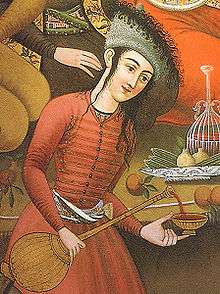Persian wine
Persian wine, also called Mey (Persian: می) and Badeh (باده), is a cultural symbol and tradition in Iran (Persia), and has a significant presence in Persian mythology, Persian poetry and Persian miniatures.

History
Recent archaeological research has pushed back the date of the known origin of wine making in Persia far beyond that which writers earlier in the 20th century had envisaged. Excavations at the Godin Tepe site in the Zagros mountains (Badler, 1995; McGovern and Michel, 1995; McGovern, 2003), have revealed pottery vessels dating from c. 3100–2900 BC containing tartaric acid, almost certainly indicating the former presence of wine. Even earlier evidence was found at the site of Hajji Firuz Tepe, also in the Zagros mountains. Here, McGovern et al. (1996) used chemical analyses of the residue of a Neolithic jar dating from as early as 5400–5000 BC to indicate high levels of tartaric acid, again suggesting that the fluid contained therein had been made from grapes.[1]
As Zabihollah Mansouri writes in Sarzamin Javid or Immortal Land Persian: سرزمین جاوید or Sarzamin-e Javid] (by Zabihollah Mansoori), Ramian wines were world-famous in the Parthian Empire.
Legends and myths
According to Iranian legend, wine was discovered by a girl despondent over her rejection by the king. The girl decided to commit suicide by drinking the spoiled residue left by rotting table grapes. Instead of poisoning the girl, the fermented must caused her to pass out to awaken the next morning with the realization that life was worth living. She reported back to the king her discovery of the intoxicating qualities of the spoiled grape juice and was rewarded for her find.[2]
Depiction in Persian miniatures
Miniature painting in Persia developed into a sophisticated art in which the most important element that all these paintings share is their subjects. The subjects that are mainly chosen from Hafez’s “Ghazaliyat” or Khayyam’s Rubaiyat. Therefore, the Persian wine, Mey, and Persian wine server (or cup bearer), Saghi, are essential parts to a majority of these paintings. Usually, the old man in the painting is Hafez or Khayyam, who, having left his scholarly position and books behind, is now drunk in Kharabat (a mystical rundown tavern located in a remote and poor corner of town) or in Golshan (garden) drinking wine from the hands of gorgeous Saghis.
In Persian poetry, grapes and wine appear frequently with symbolic, metaphorical, and actual meanings.
See also
- Persian culture
- Shirazi wine
- Beer in Iran
References
- "New York Times Article, "For Wine, 5000 BC Was Quite a Year", June 6, 1996"
- G. Harding “A Wine Miscellany” pg 7, Clarkson Potter Publishing, New York 2005 ISBN 0-307-34635-8